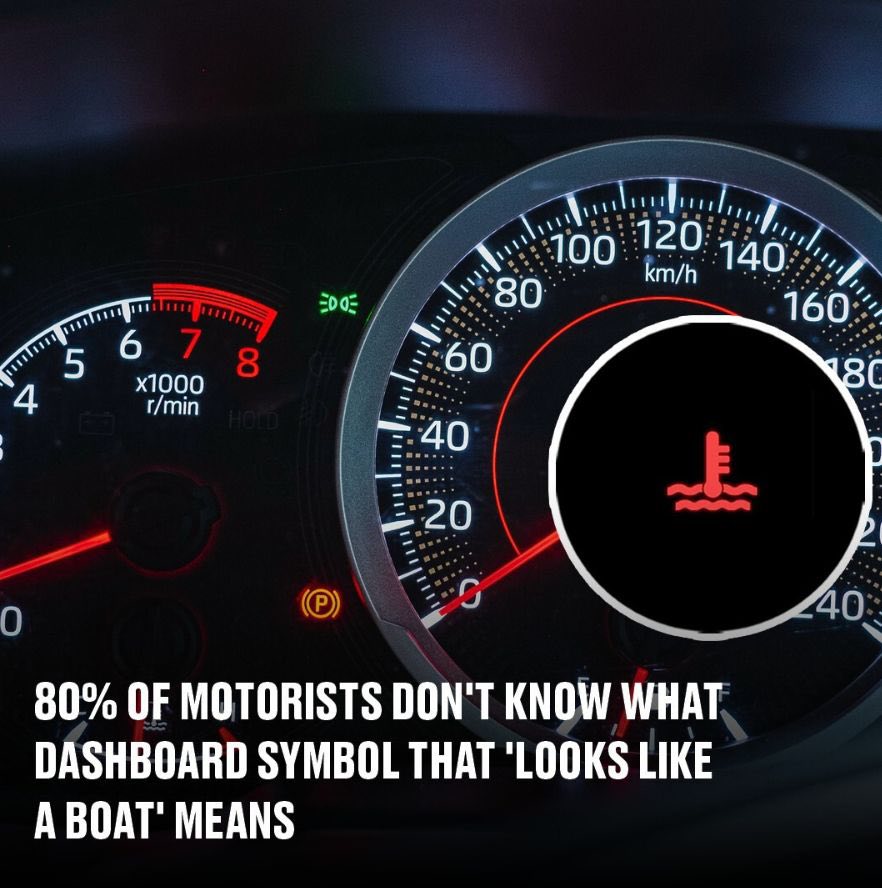Dashboard warning lights can feel like an alien language to many drivers. With so many symbols glowing, flashing, or blinking, it’s easy to feel overwhelmed, especially when an unfamiliar one suddenly lights up. While most people recognize the low fuel light or the seatbelt warning, there’s one symbol in particular that seems to baffle drivers everywhere. It’s a little icon that many people joke looks like a boat. However, this symbol is far from something you should laugh off—it’s an important indicator, and ignoring it could lead to severe engine damage.

A recent survey by ATS Euromaster revealed a startling fact: 80% of drivers have no idea what this dashboard symbol actually means. It’s not just a quirky light; it’s your engine coolant warning light. The icon itself looks like a thermometer hovering over wavy lines, and despite the jokes on social media, it has nothing to do with boats or smooth sailing.
This symbol is essentially a distress signal from your car’s cooling system. It indicates that your engine is either overheating or there’s a problem with the coolant levels. When your engine temperature rises too high or coolant levels drop dangerously low, the engine risks overheating. If left unaddressed, this can lead to extensive damage, including warped engine components, cracked cylinder heads, or even a completely blown engine. Repairs for these types of issues can easily run into the thousands.
The confusion around this symbol became a viral sensation when a user on X (formerly Twitter) shared an image of their dashboard with the light circled. The caption read, “What does this light mean?” Responses flooded in, ranging from playful jokes like, “That’s the ‘pirates approaching’ warning. Better start paddling!” to genuine attempts to help. One user confidently claimed, “It means your engine hasn’t warmed up yet. Once it does, the light will turn off.” Unfortunately, that explanation was incorrect as well.
The truth is simple: this light is a warning that your engine’s cooling system is compromised. If it turns on, it’s not a suggestion—it’s a command to take immediate action. According to advice from Eden Motor Group, the first thing you should do when this light turns red is pull over safely and turn off your engine. Continuing to drive with an overheating engine is one of the fastest ways to cause irreversible damage.
Once you’ve safely stopped, let your engine cool down before even thinking about opening the hood. Hot coolant is pressurized and can cause serious burns if the cap is removed too soon. Wait at least 30 minutes before inspecting the coolant reservoir. Most reservoirs are transparent with maximum and minimum level markers. If the coolant level is low, you can carefully top it off with the manufacturer-recommended coolant.
However, low coolant levels aren’t always the root cause of the problem. According to Eden Motor Group, the issue could also stem from a sensor failure or a coolant leak. Common culprits include cracked hoses, a leaking radiator, or a malfunctioning water pump. Sometimes, leaks are easy to spot—you might notice puddles of coolant under your car, a hissing sound from the engine bay, or even a sweet smell, which is characteristic of coolant.
If you can’t identify the problem or don’t feel confident performing these checks yourself, it’s best to call for roadside assistance or have your vehicle towed to a trusted mechanic. Driving with a compromised cooling system isn’t worth the risk.
Prevention is always better than cure when it comes to your car’s cooling system. Regularly check your coolant levels, inspect hoses for cracks, and keep an eye on your radiator’s condition during routine maintenance. These simple steps can help you avoid seeing that dreaded warning light in the first place.
In summary, the dashboard symbol that looks like a boat isn’t nautical at all—it’s a thermometer over wavy lines, and it’s one of the most critical alerts your car can give you. It signals a problem with your engine’s temperature or coolant system, and ignoring it could lead to catastrophic damage. When it lights up, don’t panic—pull over, let your engine cool, check your coolant levels, and seek professional help if necessary.
Understanding dashboard warning lights isn’t just about protecting your car; it’s about keeping you and your passengers safe. The next time you see this mysterious symbol, you’ll know exactly what it means and, more importantly, exactly what to do.